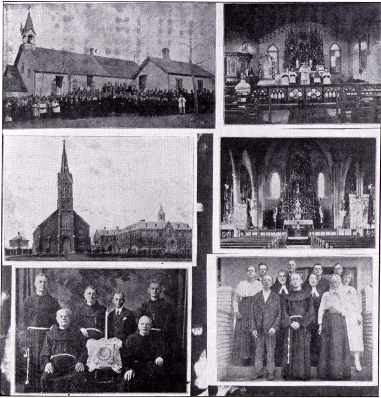
NEGenWeb Project
Church/Catholic
Franciscans
Mass was resumed at St. Michael's on their patron feast.
A SISTERS' RESIDENCE GOES UP
The parish of St. Michael's was now beginning to make progress. In the spring of 1891, a Sisters' residence was built in anticipation of the coming of the Sisters of St. Francis from Lafayette, Indiana. On September 25, 1891, three Franciscan Sisters were welcomed to Tarnov. They were Sisters Bartholomaea, superior; Adolphina, assistant teacher; and Catherine, house Sister. They were escorted in solemn procession from the depot to their residence by the pastor and his people.

Exterior and Interior of Old St. Michael's Church and Pastoral Residence.
Exterior and Interior of Present Church.
Rev. Wolfgang, Rev. Josaphat, Mr. John and Rev. Flavius Kraus, O. F. M.
Rev. Ladislaus and Rev. Dennis Czech, O. F. M.
Silver Sacerdotal Jubilee of Rev. Josaphat Kraus, O. F. M.
The Jan Jaworski Family.
ENLARGEMENT OF THE CHURCH
In January, 1892, it was decided to enlarge the church and build a sacristy. Work was begun April 8, 1892. A sum of $600 was borrowed from St. Louis and Mr. Weibel, of Humphrey. Jan Lis, of Tarnov, did the carpenter work. The cost of the improvements was $1,310 and the entire debt was cancelled by March 1, 1894.
The altar installed at this time was the gift of several parishioners, among whom might be mentioned Juliana Augustyn, John and Magdalena Lis, Jan and Agnes Mostek, Paul and Agatha Maslonka, John and Agatha Placzek, George and Mary Starzec, Augusta Korus and Adam and Mary Korus.
The pulpit was paid for by John Torczon and his wife; the two processional lanterns by Joseph Zaucha and Michael Mostek; the two statues of angels at the side of the tabernacle and the statue of St. Joseph by Joseph Jazwiec; the statue of the Blessed Virgin of Lourdes by the Rosary Society; three sanctuary chairs by Adam Pejor (Pier) and the bell in the steeple by Joseph Paprocki.
In 1886, the Poles living near Platte Center bought a chalice for $60 and a chandelier for $50.
398
![]()
INCORPORATION OF THE CHURCHHARD TIMES
On January 18, 1893, St. Michael's church of Tarnov was incorporated under the laws of the State of Nebraska. The trustees being the Rt. Rev. Richard Scannell Bishop of Omaha, the Very Rev. Wm. Choka, Vicar General of the Diocese, the Rev. Anastase Czech, pastor at Tarnov and the two lay members, John Jaworski and Stanislaus Szawica.
The years 1893, 1894, 1895 were hard ones for the farmers in the vicinity of Tarnov on account of the extreme drouth, which ruined the crops. Nevertheless a fence was built around the Sisters' residence and some trees were planted.
FATHER LADISLAUS CZECH,
O. F. M.,
ASSUMES CHARGE PLANNING THE NEW CHURCH
Realizing that a new church was a crying necessity for the ever growing parish, Fr. Ladislaus quietly accumulated $1,800 before he proposed the matter to his people. To prevent opposition, he held the first meeting (probably Dec. 17, 1899) in church after removing the Blessed Sacrament. He then preached a powerful sermon on the Catholic church and what it means to the Catholics. Then he explained the need of a new church. After the sermon he told them that he did not favor assessing them; he, therefore, asked them to write the sum they were able and willing to contribute in three annual installments for a new brick church. He did not call a meeting in school, because he had reason to fear they would not put in their appearance, in order to escape contributing. Gathering in the subscriptions, the pastor retired for some time to the sacristy, quickly summarized the amounts subscribed and proceeded with the services. He then announced a meeting in school, where he would announce the result of the subscriptions. Of course, curiosity to learn the outcome, attracted them. Fr. Ladislaus then informed them that it was unnecessary to vote on building a new church, because their subscriptions proved that they were in favor of a new brick church, because a sufficient amount had been subscribed. When it was objected that there were not enough funds, he replied that a sum of $1,800 was already on hand, and that there were enough pledges to safely proceed with the project. He also requested the parishioners to leave him a free hand in regard to the building, since he was no longer a young man, had been in many churches, and would consult his own confreres (sic) and the Brother architect of the Province; that they had no experience in building a church, though they might know well enough how to build a house. He would likewise plead for harmony, for even if they had ever so much money, this would not give them a church without union and harmony; for as the old proverb had it, "Too many cooks spoil the soup." Whereupon one of the men remarked that they even eat it up.
ERECTION OF THE NEW ST. MICHAEL'S CHURCH
Fr. Ladislaus thereupon made a trip to Omaha, ordered the material, especially lumber and bricks, and then directed the people to haul the material from the depot and the brick from Humphrey. Old Mr. John Jaworski came to the pastor and inquired, "Why build in such a hurry? I am certainly not against it, but we don't have to be in such a rush about it." Fr. Ladislaus replied: "One must forge the iron while it is hot; one must proceed while the people are willing. Johnny, I did that purposely, because now I have it all in my hand, and if I had waited longer, everything would have miscarried. Some would have wanted a frame church, others a brick church, and still others none at all."
Excavating was begun in 1899. The people helped willingly and the church was finally ready for dedication. It had cost only about $10,000 without the frescoing and the furniture, or about $14,000 including the latter. But how was it possible to build so cheaply? a doubtful Thomas may ask. Father Ladislaus, in a letter addressed to Sr. M. Concordia, and meant also for Father Eugene, adduces the following reasons: Good luck or rather the help of God, Who wisely disposed matters; in particular: 1. The Omaha Trans-Mississippi Exposition, held June 1-November 1, 1898. After getting from Brother Leonard Darscheid, O. F. M., figures on the amount and kind of lumber needed, Fr. Ladislaus bought it on the exposition grounds; also the bricks that had been used as sidewalks and were as good as new, he purchased at a very reasonable price. The same is true of the lumber, furnished by the "Chicago Wrecking Company", which threw a few large doors into the bargain. When Fr. Jerome Hellhake, O. F. M., who had just built a frame church at Platte Center, was asked to estimate the cost of the lumber purchased, he gave his estimate as $3,000, but was told that the cost was only $800. As the Wrecking company failed to extract the nails, as per contract required, Fr. Jerome smiled; Fr. Ladislaus, however, had the school boys extract the nails and used them again, thus saving quite a sum of money, besides promptly deducting about $70 from the bill of the Wrecking Company for failure to extract them. 2. Our Brother Architect lent his services gratis. 3. Fr.
399
![]()
Ladislaus purchased the common brick at Humphrey and the rest at Omaha for less than half price by appealing to the pride of the Humphrey brickyard that it would be a shame, if they failed to get the contract, and that the hauling would be done by his farmers. He got them for $4.50 minus a discount upon payment, while another pastor had to pay about $7 for the brick used in the wall around the monastery garden. 4. Fr. Ladislaus himself bought the cut stone from Florena, Kansas, near Lincoln, very cheaply. When a farmer of the St. Anthony's vicinity saw all the cut stones and other stones, he exclaimed in wonderment: "Jesus, Maria! Was machen Sie, Pater, so eine Kirche zu bauen.". ("Jesus, Maria! Father, what are you doing in building such a church?") S. Getting reduced freight rates from the U. P. railroad through the kindness of Mr. Orr at Omaha. 6. By not employing a general contractor and subcontractors. The pastor himself let these contracts. He awarded for a very reasonable sum the stone work to the Zuerlein Brothers, of Humphrey, and the brick work to Mr. Derr, of West Point. The carpenter work was alotted to Mr. John Lis, who worked for a low sum; Mr. Konwinski, who assisted him, worked for a dollar a day. Besides, Mr. Lis donated a window near the side altar. 7. Brother Leonard obtained the finishing lumber at a very low price and also the frescoing. This was Mr. Hepfinger's first job for Brother Leonard. The same economical purchase is true of the pews, altars, stained glass windows, etc. 8. The people of the parish did much work gratis. For hauling the sand they even drove one day to the sand pit near Oconee and came back the next day, so that Mr. Derr, a non-Catholic, praised the zeal of the parishioners, saying: "One would not find such zeal for their church among the non-catholic people, as to make so many and so great sacrifices for their church." Besides, the people, while building operations went on, contributed much more than they had at first promised and many wished to, donate a window, a statue, etc.--Thus Father Ladislaus.
TROUBLES
As a good work seldom goes unchallenged, but meets with opposition; so also the building of the Tarnov church. Some tried to keep the people from contributing unless the deed for the church be made in the name of the people instead of in the Bishop's name, or at least in the name of both the Bishop and of the people. One woman approached the pastor with this proposition: If Father Ladislaus comply with this demand, her husband would also contribute his share. But the pastor was equal to the occasion and told her: "We will get along without you; we will get a new church and, perhaps, you will not get to see it." These words proved to be prophetic and the woman died before the completion of the fine edifice. The pastor, moreover, cautioned his people to discountenance such talk; that the Rt. Rev. Bishop would not eat up their church; that unless they behaved, the Bishop would not give them a priest and divine service would be discontinued; to learn a lesson from the occurrence at Omaha (St. Paul's Church), where the people tried to get along without the Bishop, and where a schismatic priest or one who posed as a priest was called in and the church was finally reduced to ashes. He also reminded them that the church was already incorporated and that they had better look after the deeds of their own property.
Another source of trouble was the rumor noised abroad that the church would cost $40,000 and that the building of the church would bankrupt the farmers. Of course, that would have been the truth under ordinary circumstances. Fr. Ladislaus, however, who had been in business as a youth, had got all necessary information on the cost of the material before hand. Yes, as the people contributed so liberally, when the building was progressing, the pastor was able even to put in all the new furnishings and to have the church decorated and even to put up statues imported from Munich. Despite all these things, the cost of the shell of the structure was not even $10,000, exclusive of the interior furnishings and in about four years after the dedication of the edifice the indebtedness had been wiped out.-Thus Fr. Ladislaus.
DEDICATION OF THE NEW ST. MICHAEL'S CHURCH
At last the church was ready for dedication. Tuesday, Oct. 22, 1901, was the day set for the solemnity. From the Humphrey Democrat of October 25, 1901, we adapt the following: This beautiful edifice stands on a conspicuous place commanding a fine view of the surrounding country and will ever remain a lasting monument to the untiring efforts of the energetic and prudent pastor and the generous and devoted Polish parishioners. Work on the church was begun in the spring of 1900 and completed (including the inside decorations) on the day of dedication. It being an ideal day, the occasion was made a holiday by the people of the vicinity. At a conservative estimate, 2,000 people and the following clergymen were present: Fr. John Mueller of Petersburg; Fr. de Vos, of Spalding; Fr. F. Schnuettgen, of Howell; Fr. Vermeulen, of Spalding; Fr. Velachkievich, of Norfolk; and the Franciscan Fathers, Floren
400
![]()
tius Kurzer, Hyacinth Schroeder, Lullus Seeboth, Rembert and Theobald Kalamaja.
DESCRIPTION OF THE NEW CHURCH
The Gothic edifice is built of stone and dry pressed brick, 45x110 ft., with steeple 110 feet high. The interior is richly finished and decorated in the best of taste. The principal donors of the altars, the statuary, etc., are: Jan Barnas, Jan Jaworski, and Stanislaus Barnas. Jan Torcson paid for the pulpit. B. Nosal and Jan Jaworski, for the new canopy; N. Nosal, for a new monstrance; the ladies of the parish for the statues of the Sorrowful Mother, St. Joachim and St. Anne; the young men, for the statues of St. Peter and St. Paul, St. John and for a missal. The children gave the angel statues while the Confirmation class presented a large candlestick. The Crucifix on the high altar is a memorial of Mrs. Sophie Paprocki; the statue of St. John, of Jan Barnas; the statue of the blessed Virgin, of Joseph Korus; that of St. Stanislaus, by a number of young men bearing that name; the cross on the steeple of Stanislaus, Joseph B. and John Paprocki. The memorial windows are the gift of: Andrew Bogus, Blazy Ciochon, Thomas Pizcek, George Starzek, Joseph Zaucha, Joseph Matea, Jacob Syslo, Mike Mostek, Walenty Torczon, John Szawicka (Silver), Barthol Nosal, August Kielbasa, Frank Hansel, Augusta and John Korus, Jan Jaworski, Jan and Stanislaus Torczon, Joseph and Jan Jaswice. The fourteen artistic stations of the cross imported from Europe were given by: Jan Jaworski, Stanislaus Ciochon, M. Moryk, John Gorka, John Koziol, Joseph Slawinski, W. Starzek, Stanislaus and John Zaucha, Joseph Zaucha and John and Paul Podraza, Adam Pier, John and Anna Brudny, Joseph Paprocki and John Placzek. This list does not include minor donations.
According to the publication book the first couple to be married in the new church were John Ciochon and Mary Jaworska.
A new pipe organ was purchased by the congregation in 1902 from Pfeffer & Co., of St. Louis, Missouri, for $800. The altar, pulpit and communion rail are from B. Ferring, of Chicago, Illinois. The statue of the Savior in the tomb is a gift of Andrew Lis.
THE OLD CHURCH IS CHANGED INTO A SCHOOL
After divine service was held in the new church, the old church was converted into a school with three classrooms and another part turned into a winter chapel. In April, 1905, a telephone was installed.
THE SILVER JUBILEE OF ST. MICHAEL'S, A. D. 1905
On September 25, 1905, the twenty-fifth anniversary of the organization of the parish was commemorated. As the Rt. Rev. Bishop R. Scannell was prevented from officiating, the Very Rev. Provincial Hugolinus Storff sang the solemn High Mass and preached the English sermon, while the Rev. Theobald Kalamaja, O. F. M., of Omaha, delivered the Polish sermon. The mixed choir directed by Ven. Sr. M. Aquina, O. S. Fr., rendered Stehle's Preismesse. At the offertory the choir sang "Laudate Dommum", which emphatically expressed the feelings that filled all hearts. After High Mass a procession with the Blessed Sacrament was held around the church amid the devout prayers of the worshipers, the solemn singing of Eucharistic hymns, the melodious pealing of the bells and the sweet strains rendered by the Tarnov Band, all passing underneath the triumphal arches. Besides the two large church banners, the children, wearing fine sashes, carried the fifteen smaller banners, on which were emblazoned the fifteen mysteries of the Holy Rosary. Twelve Franciscan Fathers were present for the celebration. The procession over, Sacramental Benediction was imparted in church and the solemn strains of the Te Deum fittingly closed the religious celebration. The good Sisters afterwards provided for the bodily needs of the guests.
A HOLY MISSION
In October a hand-embroidered banner for St. Aloysius Young Men Society was imported from Europe, the cost being $163. A successful Holy Mission was preached from September 1-10 (or 12) by the Jesuit Fathers, Aloysius Warol and John Beigert. The excellent attendance at the mission exercises and the conduct of the parishioners afterwards showed that the good seed had fallen on good ground.
The indebtedness of $1,850 still encumbering the church was liquidated in about four years.
According to the church records there were in these 25 years 692 baptisms, 106 marriages, 138 burials, 234 First Communicants and 336 persons were confirmed. The parish in the year of the jubilee numbered 115 families with 120 children attending school. The membership of the Rosary Confraternity was 140, that of St. Aloysius Society 71 and that of the Young Ladies Sodality 41. The parish was in good condition spiritually and financially-reasons enough to be grateful to the Almighty for the many favors received during the past quarter of a century. May the blessing of Almighty God also continue for the future.
401
![]()
ST. MICHAEL'S ENTERS UPON ITS SECOND QUARTER OF A CENTURY
In February, 1906, two pianos were purchased, one for the sisters and one for the school. In this year $500 were spent to procure fine vestments and emblems to be carried in procession. In 1906, the chapel and altar were repainted and a carpet was purchased for the sanctuary by the young ladies. In November a new shed was built for the Sisters (cost $190). In March, 1907, the statue of the Risen Savior was purchased ($70). In spring, 1907, a large, substantial sidewalk was built near the school and around the parsonage.
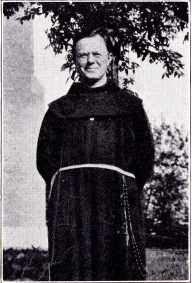
Rev. Knute Lobinski, O. F. M.
BEAUTIFYING THE CHURCH GROUNDS
In 1907, an orchard was planted west of the church and shade trees-ash and maplearound the greater part of the property; spruce on the inside of the fence and shrubs and flowers near the pastoral residence, the Sisters' residence and on the cemetery. Mr. Backes, of the Humphrey Nursery, furnished them. The basement of the church received a new floor.
CONFIRMATION ON MAY 9, 1908
Forty horsemen, under the direction of Jacob Nosal, went half way to Humphrey to escort the Rt. Rev. Bishop R. Scannell. A class of seventy-seven children, including a few adults, were confirmed. After the Bishop had spoken, especially on the importance of the Catholic schools and had examined the children in English in their Catechism, he seemed well pleased. Fr. Ladislaus delivered the Polish sermon. The sponsors were Mssrs. Frank Handzel and Blase Ciochon for the boys and Mrs. Balbina Barnas for the girls. Amid the ringing of the bells the Bishop was again escorted by the forty horsemen on his way back to Humphrey.
A HAIL STORM, ETC.
In May, 1908, on Ascension Day, Tarnov and vicinity was visited by a terrific hail storm and west wind. It did much damage, entirely ruined the farmers' winter wheat and broke one hundred window panes in Sisters' house, school and sacristy. In spring, 1900, Mrs. John Torcson donated a white cope made at Lafayette (cost $75). Stanislaus Koziol put a new foundation under the priest's house. In January and February snow storms were very severe and there were sand storms in spring and electric storms in summer. The church was struck by lightning on July 9, 1909, but the damage was slight. In September lightning rods were put on the church.
VISIT OF RT. REV. BISHOP PAUL RHODE, OF CHICAGO, ILLINOIS
On December 14, 1909, it seems, Tarnov had the great honor of welcoming the first Bishop of Polish extraction in the United States, the Rt. Rev. Paul Rhode, Assistant Bishop of Chicago, Illinois. It was a day of great rejoicing. The prelate arrived the evening before. The village was illumined (sic) with candles and Japanese lanterns and the church bells pealed forth a sincere welcome. Though the next day was cold and windy, the people turned out well. The school children and the young men met the Bishop at the priest's residence and escorted him to the church. At his entrance the choir sang the Ecce Sacerdos; then High Mass followed. Afterwards the Rt. Rev. Bishop addressed the congregation in Polish, urging them especially to erect a new school for the increasing parish. After the Sisters had served dinner, the Bishop left on the train. Amid the pealing of the bells, the people accompanied him to the railroad station.
BUILDING A NEW SCHOOL, SISTERS' HOME AND PASTORAL RESIDENCE
Most of the older people had been against building a new school; now the sentiment seemed more favorable. About $10,000 was on hand. On January 30, 1910, more than $17,000 had been promised.
NEW SCHOOL AND CONVENT
Father Denis, having obtained the necessary permission, excavation for the new school was begun September 30, 1910. Rev. Brother Leonard Darscheid, O. F. M., who had designed the Tarnov church, also designed the new school.
402
![]()
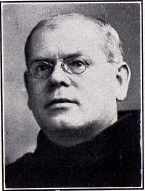
Rev. Ladislaus Czech, O. F. M.
The pressed brick were purchased from the Sioux City Paving Brick Company and 275,000 second-hand bricks from Fremont at $5 per thousand. In February, 1911, the people started to haul the material from the Tarnov depot and from the lumber yard at Humphrey. Mr. Joseph Paprocki was made the overseer. Mr. Williams, of Chicago, was the contractor for the concrete and brick work. The foundation was laid on March 20. Mr. Dan Egan, of Ashland, Wisconsin, had the contract for the brick work. By August the shingles were on the roof. The plumbing and steam fitting was done by Dussel and Son, of Columbus. The church and parsonage are heated by the same plant and lighted by acetylene. The piping was done by Herbeson & Co., of Norfolk, Nebraska, the wiring by Mr. Armagust, of Central City. Mr. Hollenbeck, from the Chicago Company, procured the generator. The light was burning for the first time the evening before the dedication. The generator was installed in a cave, fifty feet away from the house. The bricklayers were largely from Sioux City, also the plasterers; the carpenters, mostly from Ashland, Wiscon-
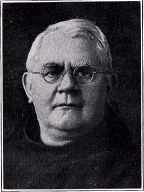
Rev. Rembert Stanowski, O. F. M.
sin. There were five Negroes among the workmen. The disappearance of chickens, the accommodating of so many strangers in the small village and the occasional sprees of some workers caused considerable anoyance. The building was to be finished at the end of September. The dedication had to be postponed, however, till November 21, 1911.
THE DEDICATION OF THE NEW SCHOOL,
SISTERS' RESIDENCE AND OF THE NEW PASTOR'S HOUSE
The dedication of the new school, Sisters' residence and the new pastor's house occurred on November 21, 1911. Rt. Rev. Bishop Paul Rhode, who two years before had given a mighty
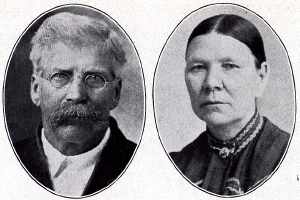
Mr. and Mrs. Paprocki.
impetus to the building of the new school, was invited to perform the ceremonies of the dedication. On the evening of November 20, the Prelate arrived, accompanied by Rev. Fr. Theobald, and some other priests. It was a beautiful evening-mild, quiet and starlit. Ven. Brother Leonard had arranged a torch light procession with the young men's Sodality. The procession extended from the depot to the church.
403
![]()
|
|||